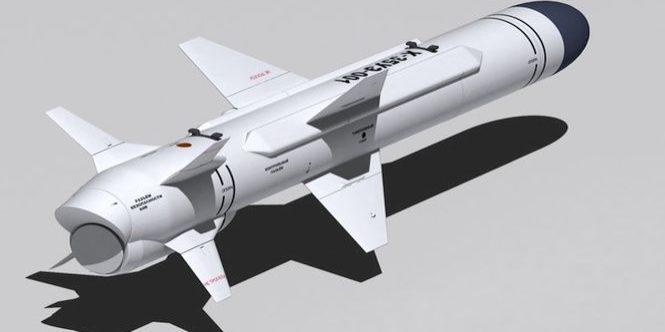Facts
| Russian/NATO Designation | KH-35/SS-N-25 Switchblade |
| Variants | KH-35U |
| Mobility and Role | Surface-to-Surface, Air-to-Surface, Anti-Ship Cruise Missile |
| Designer/Producer | Zvezda-Strela State Scientific-Industrial Center |
| Range | 300 km |
| Warhead Type and Weight | Conventional -480 kg |
| MIRV and Yield | No MIRV/Unknown |
| Guidance System/Accuracy | Inertial; Glonass; Active Radar Seeker |
| Cruise Altitude | 5-15 m |
| Stages/Propellant | Two/Liquid |
| IOC/Retirement | 1983/Still Active |
| Status/Number of Units | Operational /Unknown |
| Launch Vehicles | Su-35, Yak-141 fighters; MiG-27, Su-25, Su-39 attack aircraft; Ka-28 helicopter; Tu-142 bomber; various surface ships |
Overview
The KH-35 is a subsonic, anti-ship cruise missile that was originally developed in 1983 by the Soviet Union.[1] It has a two stage, liquid fueled propellant and weighs 480 kg and can be launched from fighter jets, attack helicopters, bombers, and naval surface ships. Its modern variant, the KH-35U, was deployed in 2003 and will be equipped on Russia’s fifth-generation fighter aircraft, the Sukhoi PAK FA.[2] The KH-35U uses inertial guidance with a Glonass Receiver and an active radar seeker to find its target.[3] Russian officials claim that the KH-35U is immune to enemy countermeasures.[4]
Strategic Implications
The claim that the KH-35U is immune to enemy countermeasures, if true, makes it an extremely dangerous weapon, especially when coupled with Russia’s fifth generation Sukhoi PAK FA stealth fighter aircraft. Ultimately, improved air defense countermeasures could enable the KH-35U to strike vessels deep within contested airspace, providing Russia with a substantial advantage on the battlefield.
In 2014, North Korea unveiled its Kumsong-3 anti-ship cruise missile, which appears to be a variant of Russia’s KH-35 weapon system. It remains unclear as to how North Korea acquired the Russian cruise missile, but some reports suggest that Pyongyang acquired the weapon directly from Russia.[5] North Korea’s KH-35 variant provides the rogue state with added capability against U.S. and allied vessels operating along the coastlines of the Korean Peninsula; compounding the North Korean threat to U.S. interests in the region.
Sources:
[1] http://www.globalsecurity.org/military/world/russia/as-20.htm
[2] https://sputniknews.com/military/201705121053551612-kh35-anti-ship-missile-designer-interview/
[3] http://www.ausairpower.net/APA-Rus-Cruise-Missiles.html#mozTocId501956
[4] https://sputniknews.com/military/201705121053551612-kh35-anti-ship-missile-designer-interview/
[5] https://missilethreat.csis.org/missile/kumsong-3-kh-35-variant/

